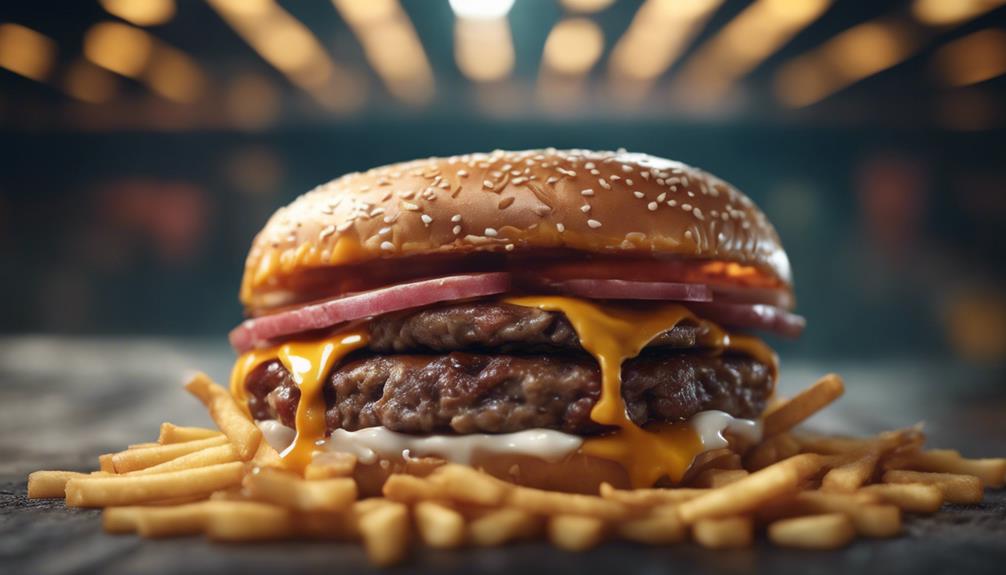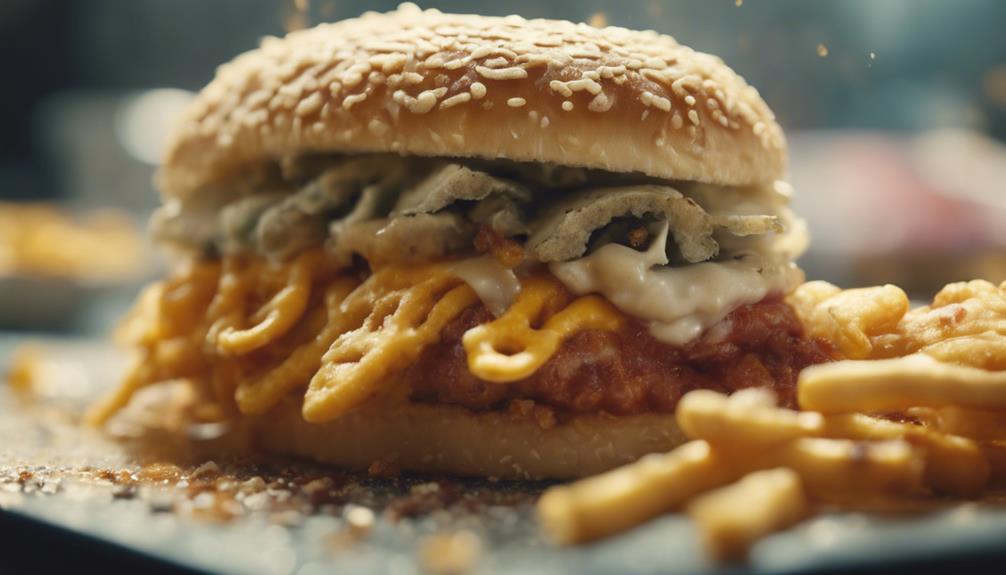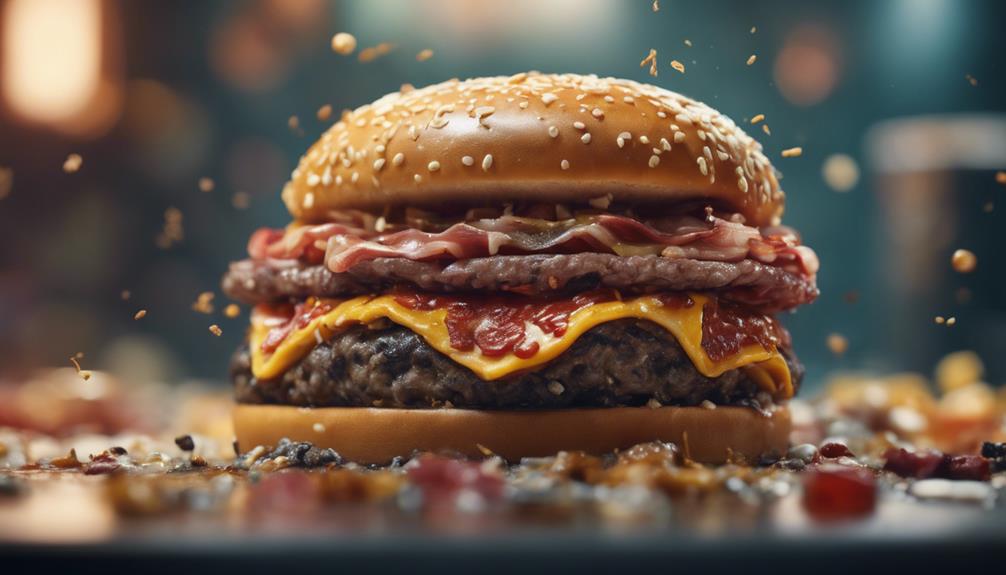Hidden within the seemingly innocent facade of fast food lie disturbing truths that will shock even the most unwavering consumers. From condoms, nails, and Band-Aids to unsettling finds like chicken heads, rat's heads, and even animal lungs, fast food has been the unexpected stage for some truly bizarre discoveries. Contaminants like meth, human skin, and even a syringe have also made appearances, raising serious food safety concerns. Popular chains have not been immune, as incidents with foreign objects have led to legal actions. The unsettling reality of what's really in your favorite fast food will make you question your next order.
Key Takeaways
- Condoms, nails, Band-Aids found in fast food items.
- Unsettling animal parts like chicken heads and rodents found in meals.
- Disturbing contaminants like meth, human skin, and syringes reported.
- Bizarre discoveries like snake and rat heads found in popular chains.
- Serious food safety concerns with razors and band-aids in fast food.
Shocking Foreign Objects in Fast Food
Foreign objects like condoms, nails, and even Band-Aids have been disturbingly discovered in various fast food items, raising serious concerns about food safety standards. In a particularly unsettling incident in New York, a customer found a condom in their Big Mac, prompting investigations into how such a shocking discovery could have occurred.
Similarly, another patron was shocked to discover a condom in their Happy Meal, prompting questions about the integrity of fast food preparation processes. The discovery of nails in a serving of mac-and-cheese further underscored the potential risks associated with foreign objects in fast food items.
In another alarming case, a customer was served a metal-stuffed donut, leaving many questioning the quality control practices in popular fast food chains. Additionally, the finding of Band-Aids in McDonald's fries highlighted the critical need for thorough food inspection and handling procedures.
These incidents serve as stark reminders of the importance of maintaining stringent food safety measures in the fast food industry to prevent such disturbing occurrences.
Unsettling Animal Parts in Fast Food

Customers have reported unsettling discoveries of animal parts in various fast food items, including finding a chicken head in a Happy Meal, a mouse in a curry jar, a rat's head in a Popeyes order, and a snake's head at TGI Fridays. These incidents have raised serious concerns about the quality control measures in place at fast food establishments. Cases such as a lung attached to fried chicken at KFC and a dead mouse in a soda have further fueled these worries.
Discoveries like a cockroach in a hash brown and a rat's head in a Popeyes order have highlighted potential lapses in food safety protocols within the fast food industry.
Reports of a snake's head at TGI Fridays and a lung attached to fried chicken at KFC have initiated discussions about the necessity for stricter food safety standards. Instances of finding a dead mouse in a soda emphasize the possible health risks associated with consuming fast food contaminated with animal parts. These unsettling findings underscore the importance of rigorous inspections and monitoring to guarantee the safety and quality of fast food offerings.
Disturbing Contaminants in Fast Food

Disturbing contaminants have been uncovered in various fast food items, raising serious concerns about food safety standards. The presence of meth on In-N-Out's secret menu and human skin in an Arby's chicken sandwich has shocked consumers and highlighted the need for stricter quality control measures.
Instances such as discovering a syringe in a Burger King sandwich and a dead frog in a Pepsi drink have added to the growing unease regarding the cleanliness of fast food establishments. Additionally, reports of a bloody Taco Bell incident and a rat found in baked beans have further underscored the potential health risks associated with consuming contaminated fast food.
- Incidents of finding a syringe in a Burger King sandwich and a dead frog in a Pepsi drink have sparked concerns about food safety.
- The unsettling discoveries of a bloody Taco Bell incident and a rat in baked beans emphasize the importance of maintaining stringent cleanliness standards in fast food chains.
- The presence of meth on In-N-Out's secret menu and human skin in an Arby's chicken sandwich have raised alarms regarding the quality control of fast food ingredients.
- Consumers are increasingly wary of potential health risks after reports of disturbing contaminants like meth and human skin in popular fast food items.
Bizarre Discoveries in Popular Chains

Amidst the bustling atmosphere of popular fast food chains, bizarre discoveries have startled and appalled customers, shedding light on the unexpected items found in their meals. Instances like finding a condom in a Happy Meal, a rat's head in a chicken order, a snake's head in a TGI Fridays meal, a dead mouse in a soda, and bloody Taco Bell in a fast food item have left patrons questioning the standards of cleanliness and quality control in these establishments.
To explore further into these shocking incidents, a table highlighting each peculiar discovery is provided below:
| Bizarre Discoveries | Location |
|---|---|
| Condom in a Happy Meal | Popular Fast Food Chain |
| Rat's head in an order | Well-Known Chicken Restaurant |
| Snake's head in a meal | TGI Fridays Location |
| Dead mouse in a soda | Fast Food Establishment |
| Bloody Taco Bell | Fast Food Item |
Serious Food Safety Concerns

Serious food safety concerns have been heightened by the alarming discoveries of foreign objects and animal parts in various fast food chains. These findings have shed light on the potential health risks associated with consuming fast food, prompting questions about the quality control measures in place within the industry.
The following points outline some of the most concerning incidents:
- Instances of foreign objects such as razors in Walmart ice cream and band-aids in McDonald's fries have raised red flags regarding the safety of fast food consumption.
- Discoveries of animal parts like chicken heads in Happy Meals and rats' heads in Popeyes orders have underscored the need for more stringent food safety protocols in fast food establishments.
- Reports of contaminants like human skin in Arby's chicken sandwiches and syringes in Burger King sandwiches have sparked outrage among consumers and highlighted the importance of thorough food inspection processes.
- Legal actions, including lawsuits over foreign objects like condoms in Big Macs and Happy Meals, have drawn attention to the necessity for improved quality control standards in the fast food industry to safeguard consumer safety.
Frequently Asked Questions
What Is Your Favourite Fast Food and Why?
In-N-Out is their preferred fast food joint for its fresh ingredients, simple menu, and tasty burgers. McDonald's Big Mac and consistent taste make it a top choice. Taco Bell offers affordable and delicious Mexican-inspired items. Chick-fil-A stands out for its flavorful chicken sandwiches and exceptional service. Pizza Hut is their go-to for its variety of toppings, crust options, and quick delivery.
Why Is Fast Food so Unhealthy?
Fast food is unhealthy due to its high calorie, unhealthy fat, sugar, and sodium content. It lacks essential nutrients and is processed with additives. Large portion sizes contribute to overeating and obesity-related health issues.
What Happens if I Eat Fast Food Every Day?
Consuming fast food daily brings about a storm of health risks. Weight gain, nutrient deficiencies, and mental health struggles can brew. Beware the aftermath: obesity, heart disease, high blood pressure, and a weakened immune system.
How Often Should You Eat Fast Food?
Consuming fast food should be limited to occasional treats, not a regular habit. It's recommended to indulge no more than once a week to maintain a healthy diet. Balancing with nutrient-rich foods is essential for overall well-being.
Conclusion
In a recent study, it was found that 1 in every 10 fast food orders contains foreign objects, such as plastic or metal fragments. This shocking statistic reveals the potential risks associated with consuming fast food on a regular basis.
It's important for consumers to be aware of the potential hazards and to make informed decisions about their food choices to prioritize their health and well-being.









